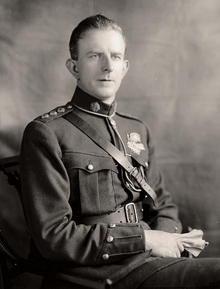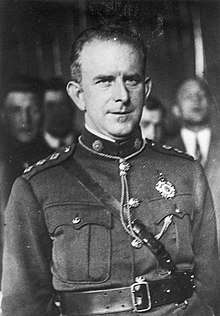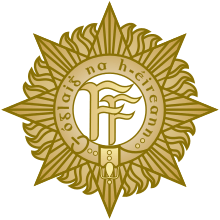Eoin O'Duffy
| Eoin O'Duffy | |
|---|---|
 O'Duffy as Commissioner of the Garda Síochána, 1922 | |
| Leader of Fine Gael | |
|
In office 4 May 1933 – 16 June 1934 | |
| Preceded by | New office |
| Succeeded by | W. T. Cosgrave |
| Garda Commissioner | |
|
In office 30 September 1922 – 4 February 1933 | |
| Preceded by | Michael Staines |
| Succeeded by | Eamon Broy |
| Teachta Dála | |
|
In office May 1921 – August 1923 | |
| Constituency | Monaghan |
| Personal details | |
| Born |
Owen Duffy 28 January 1890 Lough Egish, County Monaghan, Ireland |
| Died |
30 November 1944 (aged 54) Dublin, Ireland |
| Resting place |
Glasnevin Cemetery, Glasnevin, Dublin, Ireland |
| Nationality | Irish |
| Political party |
Sinn Féin (1917–1922) Fine Gael (1933–1934) National Corporate Party (1935–1937) |
| Military service | |
| Allegiance |
Irish Volunteers Irish Republican Brotherhood Irish Republican Army National Army Irish Brigade |
| Years of service |
1917–1933 1936–1937 |
| Rank |
General Chief of Staff |
| Battles/wars |
Irish War of Independence Irish Civil War Spanish Civil War |
Eoin O'Duffy (Irish: Eoin Ó Dubhthaigh; born Owen Duffy, 28 January 1890 – 30 November 1944) was an Irish nationalist political activist, soldier and police commissioner. He was the leader of the Monaghan Brigade of the Irish Republican Army (IRA) and a prominent figure in the Ulster IRA during the Irish War of Independence. In this capacity he became Chief of Staff of the IRA in 1922. He was one of the Irish republicans who along with Michael Collins accepted the Anglo-Irish Treaty and fought as a General in the Irish Civil War on the pro-Treaty side.
O'Duffy became the second Commissioner of the Garda Síochána, the police force of the new Irish Free State, after the Civic Guard Mutiny and the subsequent resignation of Michael Staines. He had been an early member of Sinn Féin, founded by Arthur Griffith. He was elected as a Teachta Dála (TD) for Monaghan, his home county, during the 1921 election. After a split in 1923 he became associated with Cumann na nGaedheal and led the movement known as the Blueshirts. After the merger of various pro-Treaty factions under the banner of Fine Gael, O'Duffy was the party leader for a short time.
An anti-communist, O'Duffy was attracted to various anti-communist movements on the continent. He raised the Irish Brigade to fight for Francisco Franco during the Spanish Civil War as an act of Catholic solidarity and was inspired by Benito Mussolini's Italy to found the National Corporate Party. During World War II, he offered to Nazi Germany the prospect of raising an Irish Brigade to participate in the fight against the Soviet Union, but this was not taken up.
Early life
Eoin O'Duffy was born Owen Duffy in Lough Egish, near Castleblayney, County Monaghan, on 28 January 1890. He was the youngest of 7 children and attended Laggan national school.[1] His mother died when he was 12 and he wore her ring for the rest of his life.[2]
He did an apprenticeship as an engineer in Wexford before working as an engineer and architect in Monaghan. In 1919 he became an auctioneer.
Involvement in sport
Ulster GAA
O'Duffy was a leading member of the Gaelic Athletic Association (GAA) in Ulster. He was appointed secretary of the Ulster Provincial Council in 1912. He later served as Treasurer of the GAA Ulster Council from 1921 to 1934. His important role in developing the GAA in Ulster is memorialised by the O'Duffy Terrace at the principal provincial stadium, St Tiernach's Park in Clones, County Monaghan.[3] In December 2009 a plaque was erected in memory of O'Duffy in Aughnamullen. The plaque was unveiled by the President of the Ulster GAA Council, Tom Daly.[4]
He was also a member of Harps' Gaelic football club.[1]
Other sports
As well as being a prominent figure in Ulster GAA he was also active in other sports. He was President of the Irish Amateur Handball Association from 1926–34, the National Athletic and Cycling Association from 1931–34 which he founded in 1922 and the Irish Olympic Council from 1931–32.[1]
O'Duffy believed in the ideal of "cleaned manliness". He said sport "cultivates in a boy habits of self-control [and] self-denial" and promotes "the cleanest and most wholesome of the instincts of youth". He said a lack of sport caused some boys to have "failed to keep their athleticism, but became weedy youths, smoking too soon, drinking too soon".[5]
Political activities
Irish Republican Army and Sinn Féin
In 1917, O'Duffy joined the Irish Volunteers and took an active part in the Irish War of Independence, after that organisation became the Irish Republican Army (IRA).
He rose rapidly through the ranks. He started off as the Section Commander of the Clones Company, then Captain, then Commandant and finally appointed Brigadier in 1919.[1]
On 14 September 1918 he and Daniel Hogan were arrested after a GAA match and charged with "illegal assembly". He was imprisoned in Belfast Prison and released on 19 November 1918.[1]
On 15 February 1920, he (along with Ernie O'Malley) was involved in the first capture of a Royal Irish Constabulary (RIC) barracks by the IRA in Ballytrain, in his native Monaghan. He came to the attention of Michael Collins, who enrolled him in the Irish Republican Brotherhood (IRB) and supported his advancement in the movement's hierarchy.[6]
He was imprisoned several times but became director of the army in 1921. In May 1921 he was returned as a Sinn Féin TD for the Monaghan constituency to the Second Dáil.[7] He was re-elected at the 1922 general election.[8]
In March 1921, he was made commander of the IRA's 2nd Northern Division. Following the Truce with the British in July 1921, he was sent to Belfast. After the rioting known as Belfast's Bloody Sunday, he was given the task of liaising with the British to try to maintain the Truce and defend Catholic areas against attack.[9] He was Director of Organisation in Ulster and Chief Liaison officer for Ulster at the time the treaty was signed.[10]
In January 1922 he became IRA Chief of Staff, replacing Richard Mulcahy. O'Duffy was the youngest general in Europe until Francisco Franco was promoted to that rank.
Civil War General and Garda Síochána

In 1921 he supported the Anglo-Irish Treaty. He served as a general in the National Army and was given control of the South-Western Command.[1] In the ensuing Irish Civil War he was one of the architects behind the Free State's strategy of seaborne landings in Republican-held areas. He took Limerick for the Free State in July 1922, before being held up in the Battle of Killmallock south of the city. The enmities of the civil war era were to stay with O'Duffy throughout his political career.
In September 1922, Minister for Home Affairs Kevin O'Higgins was experiencing indiscipline within the recently formed Garda Síochána and O'Duffy was appointed Garda Commissioner after resigning from the army in order to take up the position. O'Duffy was a fine organiser and has been given much of the credit for the emergence of a largely respected, non-political and unarmed police force. He insisted on a Catholic ethos to distinguish the Gardaí from their Royal Irish Constabulary (RIC) predecessors, and regularly told members of the force they were not just men working an ordinary job, but policemen fulfilling their religious duty.[11] He was also a vocal opponent of alcohol in the force, instructing Gardaí to avoid it all costs.[12]
In February, following a general election in 1933 Éamon de Valera dismissed O'Duffy as Garda Commissioner. In the Dáil de Valera explained the reason for his dismissal, stating "[O'Duffy] was likely to be biased in his attitude because of past political affiliations". The true reason, however, appears to have been the new government's discovery that in 1932, O'Duffy's was one of the voices urging W. T. Cosgrave to resort to a military coup rather than to turn over power to the incoming Fianna Fáil administration. O'Duffy refused the offer of another position of equivalent rank in the public service. Ernest Blythe said many years later that the outgoing Government had become so alarmed by O'Duffy's conduct that had they returned to power they would have also acted as De Valera did and dismissed O'Duffy as Garda Commissioner.[13]
Leader of the Blueshirts

In July 1933 O'Duffy became leader of the Army Comrades Association, an organisation set up to protect Cumann na nGaedheal public meetings, which had been disrupted under the slogan "No Free Speech for Traitors" by Irish Republican Army members newly confident after the elections. O'Duffy and many other conservative elements within the Irish Free State began to embrace fascist ideology, which was in vogue at that time. He soon changed the name of this new movement to the National Guard. An admirer of the Italian leader Benito Mussolini, O'Duffy and his organisation adopted outward symbols of European fascism such as the straight-arm Roman salute and a distinctive blue uniform. It was not long before they became known as the Blueshirts, similar to the Italian Blackshirts and the German Brownshirts.
In August 1933 a parade was planned by the Blueshirts in Dublin to commemorate Michael Collins and Arthur Griffith, both of whom had died 11 years earlier. This was an imitation of Mussolini's March on Rome and was perceived as such despite contrary claims. De Valera feared a similar coup d'état as seen in Italy and the parade was banned.
By September the Blueshirts were declared an illegal organisation. To circumvent this ban the movement once again adopted a new name, this time styling itself the League of Youth. In 1933 a group of Irish republicans, one member of which was Dan Keating, planned to assassinate O'Duffy in Ballyseedy, County Kerry, while he would be on his way to a meeting. A man was sent to Limerick to find out which car O'Duffy would be travelling in but the man purposely gave false information and O'Duffy escaped.[14]
During the early stages of the Second Italo-Ethiopian War in 1935 O'Duffy offered Benito Mussolini the service of 1000 Blueshirts because he believed the war represented the struggle between civilisation and barbarism. On 18 September, in an interview he said that the Blueshirts were volunteering to fight "not for Italy or against Abyssinia, but for the principle of the corporate system" against which "the forces of both Marxism and of capitalism" were ranged.[15]
O'Duffy and some of his men also made an appearance at the 1934 International Fascist conference in Montreux where he argued for antisemitism.[16]
Fine Gael
In September 1933 Cumann na nGaedheal, the Centre Party and the Blueshirt movement merged to form Fine Gael. O'Duffy, though not a TD, became the first leader, with former President of the Executive Council W. T. Cosgrave serving as parliamentary leader and Vice-President. The National Guard, now rechristened the Young Ireland Association, was transformed from an illegal paramilitary group into the militant wing of a political party. However, meetings were often attacked by IRA members. O'Duffy proved an unsuitable leader: he was a soldier rather than a politician, and was temperamental. His Fine Gael colleagues were embarrassed by the Blueshirts use of violence, in addition to O'Duffy's connections with foreign fascist organisations and his view of the IRA as a communist group.[1] In September 1934 he suddenly and unexpectedly resigned as leader of Fine Gael.[17]
Spanish Civil War
The Blueshirt movement had begun to disintegrate also, so much so that the organisation no longer existed by 1935. In June 1935 O'Duffy launched the National Corporate Party, a fascist political party inspired by Italy's Mussolini.The following year he organised an Irish Brigade to fight for Francisco Franco in the Spanish Civil War. He was motivated to do so by Ireland's historic link with Spain, his devout anti-communism and a will to defend Catholicism.
Despite the Irish Government advising against participation in the war, 700 of O'Duffy's followers went to Spain to fight on Franco's side. He later stated he had received over 7,000 applications but several complications meant only 700 of these made it to Spain.[18] O'Duffy's men saw little fighting and were sent home by Franco, returning in June 1937.[19] Franco had not been impressed by the Brigade's lack of military expertise and there were bitter arguments among O'Duffy and his officers about the direction of the Brigade.[18]
Later life and death
O'Duffy returned to Ireland from Spain in disarray. He wrote a book, Crusade in Spain (1938), about the Irish Brigade in Spain. The book had antisemitic undertones; O'Duffy wrote that trade unions are "powerful political Jewish-Masonic organisations, directed and focused by the Communist International."[1] He later congratulated General Franco for winning the Spanish Civil War; Franco thanked O'Duffy for his sending congratulations "on the victory of the Spanish Army in defence of Christianity, occidental civilisation and humanity, over the forces of destruction and disorder."[20]
In 1936 O'Duffy attended the founding meeting of Cumann Poblachta na hEireann but never became a member.[21] In 1939 The Irish Times reported that O'Duffy and his followers were trying to set up a new organisation however nothing materialised.[20] He was subsequently put under surveillance by the G2. In February 1939 he met up with Oskar Pfaus, a German spy whom he put in touch with the IRA. He also met the Italian diplomat Vincenzo Beradis.[1] He is thought to have met with IRA figures and members of the German consulate in the summer of 1939. In the summer of 1943 O'Duffy approached the German Legation in Dublin with an offer to organise an Irish Volunteer Legion for use on the Eastern Front. He explained his offer to the German ambassador as a wish to "save Europe from Bolshevism". He requested an aircraft to be sent from Germany so that he could conduct the necessary negotiations in Berlin. The offer was "not taken seriously".[22] By this time his health had begun to seriously deteriorate; he died on 30 November 1944, aged 54. He received a state funeral. Following Requiem Mass in St Mary's Pro-Cathedral, he was buried in Glasnevin Cemetery.[23]
References
- 1 2 3 4 5 6 7 8 9 "Eoin O'Duffy papers" (PDF). National Library of Ireland.
- ↑ "From a Free State hero to a buffoon in a Blueshirt". Irish Independent. Retrieved 18 October 2014.
- ↑ Nauright, John; Wiggins, David K., eds. (2016). Sport and Revolutionaries: Reclaiming the Historical Role of Sport in Social and Political Activism. Routledge. p. 65. ISBN 9781317519485.
- ↑ "General Owen O'Duffy Remembered". Hogan Stand.
- ↑ "Violence, citizenship and virility: The making of an irish fascist". History Ireland.
- ↑ Fearghal McGarry, 'O'Duffy, Eoin (1890–1944)', Oxford Dictionary of National Biography, Oxford University Press, 2004; online edn, Jan 2011
- ↑ "General Eoin O'Duffy". Oireachtas Members Database. Retrieved 26 March 2012.
- ↑ "Eoin O'Duffy". ElectionsIreland.org. Retrieved 26 March 2012.
- ↑ Fearghal McGarry, Eoin O'Duffy, A Self-Made Hero,Oxford University Press, Oxford, 2005, ISBN 978-0-19-922667-2 p78-80
- ↑ "Witness Statement of Captain Liam McMullen" (PDF). Bureau of Military History.
- ↑ McNiffe, Liam (1997). A history of the Garda Síochána. Wolfhound Press. p. 138.
- ↑ Wallace, Colm (2017). The Fallen: Gardaí Killed in Service 1922-1949. Dublin: History Press.
- ↑ McGarry ,pp188,386
- ↑ "Spanish Civil War veterans look back". BBC.
- ↑ "Eoin O'Duffy's Blueshirts and the Abyssinian Crisis". History Ireland.
- ↑ "INTERNATIONAL: Pax Romanizing". Time. 31 December 1934.
- ↑ MGarry pp260-269
- 1 2 "Ireland and the Spanish Civil War". History Ireland.
- ↑ Thomas Gunning, former secretary to O'Duffy, was also a "suspect" for Irish Military Intelligence (G2), having remained in Spain after the rest of the Irish volunteers for Franco departed under a cloud of recrimination. Gunning worked as a newspaper correspondent in Spain for a short time then made his way to Berlin, where he worked for the Propaganda Ministry until his death in 1940.
- 1 2 "What O'Duffy Did When He Came Home". The Irish Times.
- ↑ Eithne McDermott. "Clann Na Poblachta". p. 11.
- ↑ See Stephan, Enno: Spies in Ireland (1963) P.232
- ↑ Staff writer(s) (4 January 2008). "Cemetery's appeal very much alive". The Irish Times.
Further reading
- Fearghal McGarry, Eoin O'Duffy: A Self-Made Hero (Oxford University Press, 2005)
- For material on the Irish Bandera at the Wayback Machine (archived 28 October 2009)
- For material on the International Brigadiers from Ireland at the Wayback Machine (archived 28 October 2009).
- Eoin O'Duffy: A Self-Made Hero – Fearghal McGarry interviewed
- A review of McGarry's book at the Wayback Machine (archived 28 October 2009) by Dermot Bolger in the Sunday Independent, (Dublin) 27 November 2005.
